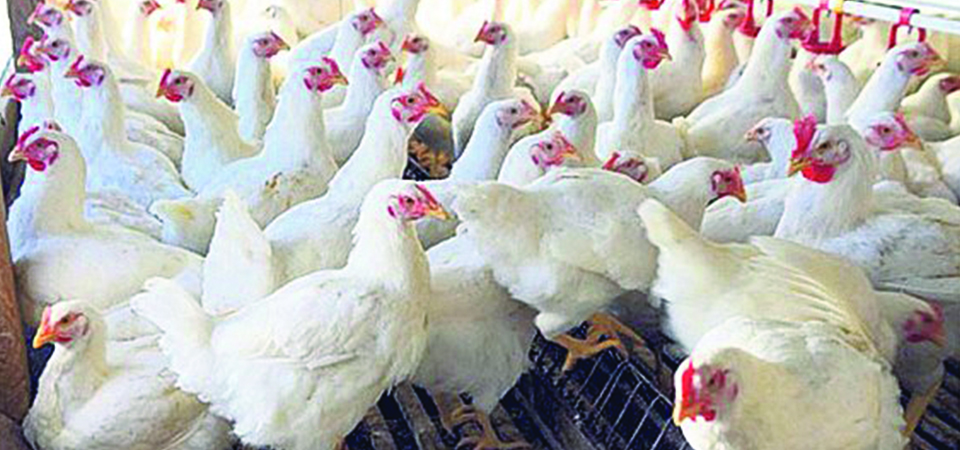Experts warn bird flu could become a pandemic

Kathmandu, Feb.17: Experts have said that a virus subtype H5N1 of bird flu, currently detected in chickens, is considered to be highly contagious and deadly not only to animals but to humans.
If not controlled then it has a 100 per cent fatality rate in chickens and can infect and spread to humans.
Dr Arjun Aryal, Senior Veterinary Officer at Central Referral Veterinary hospital, said that the H5N1 virus in bird flu is a highly pathogenic avian influenza virus in poultry, which can kill thousands of chickens on the farm and can even spread to humans.
Usually, H5 or H7 is highly contagious and can turn deadly if the infected chickens and areas are not kept under check.
He said, “One gram manure of infected chicken can infect 20 lakh of chickens at once if the disease goes undetected for even a week. H5N1 0virus may kill chickens within 24 hours and can spread to flocks within days.”
“Hemagglutinin ‘H’ and Neuraminidase ‘N’ proteins of the bird flu virus can mutate such that it may gain the ability to spread widely in animals. Similarly, human infections with novel avian influenza virus-like H5N1 are concerning because of this pandemic potential,” He added.
He informed that bird flu-infected chicken has diarrhoea, breathing difficulties, swollen head, and even death. A sick chicken sheds the virus in its feathers, mucous, saliva, and faeces. Likewise, infected humans are observed with the symptoms of cough, fever, sore throat, muscle aches, headache, and shortness of breath.
Similarly, Dr Chandra Dhakal, Spokesperson at the Department of Livestock Services under the Ministry of Agriculture and Livestock Development (MoALD), said that the H5N1 virus which has been detected in chickens currently is highly contagious and have a 100 per cent fatality rate. It even can infect humans and can spread easily.
So far, bird flu is observed in Kathmandu, Morang, and Jhapa, and thousands of chickens have been culled off to avoid further spread. Bird flu-infected chickens have been detected in Gokarneshwor and Tarakeshwar Municipalities in Kathmandu, and the areas are declared as the high alert zones and the infected chickens have been destroyed as per the guidelines of the World Health Organisation (WHO).
Following the initial detection of bird flu, the government has stepped up and kept close surveillance of the infected area. The infected place is disinfected and can be used after three months only. He further said that farmers whose chickens are destroyed because of bird flu get 75 per cent compensation as well.
So far, Nepal has only one human death record from bird flu. In May 2019, a 21-year-old poultry truck driver from Kavrepalanchowk was found infected with the bird flu virus and eventually lost his life to a virus.
According to the World Health Organisation, H5N1 is a lethal bird flu virus, which is highly infectious with a 60 per cent fatality rate in humans.
The first infection in a human was reported in 1997 in Hong Kong and the virus has since spread to Asia, the Middle East, Europe, and other parts of the world causing millions of poultry infections.
Bird flu, a viral disease, has many different combinations of ‘H’ and ‘N’ proteins. Each combination is considered a different subtype and can be broken down into different strains and by their pathogenicity, low or high, based upon the ability of a particular virus train to cause disease in chickens.
Meanwhile, Dr Sher Bahadur Pun, chief of the Clinical Research Unit at Sukraraj Tropical and Infectious Disease Hospital warned of another epidemic and suggested stepping up the surveillance systems. “Health conditions of people who come in close contact with chickens or work in poultry farms must be monitored, if the symptoms of bird flu are observed then the infected must be taken to the doctor immediately."
Recent News

Do not make expressions casting dout on election: EC
14 Apr, 2022
CM Bhatta says may New Year 2079 BS inspire positive thinking
14 Apr, 2022
Three new cases, 44 recoveries in 24 hours
14 Apr, 2022
689 climbers of 84 teams so far acquire permits for climbing various peaks this spring season
14 Apr, 2022
How the rising cost of living crisis is impacting Nepal
14 Apr, 2022
US military confirms an interstellar meteor collided with Earth
14 Apr, 2022
Valneva Covid vaccine approved for use in UK
14 Apr, 2022
Chair Prachanda highlights need of unity among Maoist, Communist forces
14 Apr, 2022
Ranbir Kapoor and Alia Bhatt: Bollywood toasts star couple on wedding
14 Apr, 2022
President Bhandari confers decorations (Photo Feature)
14 Apr, 2022











